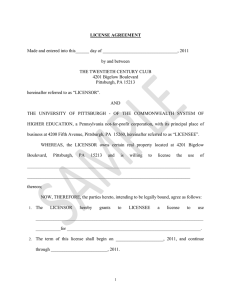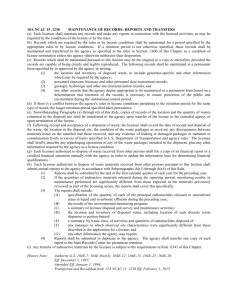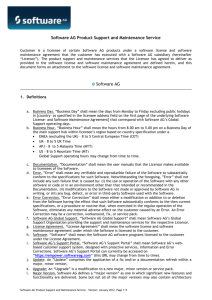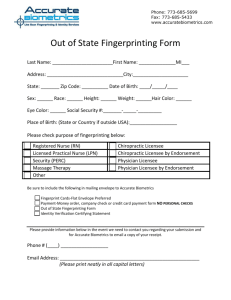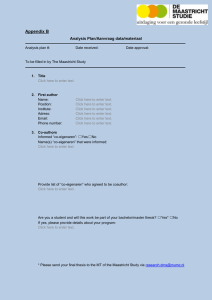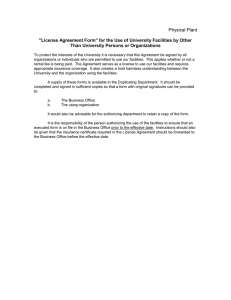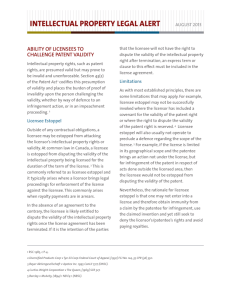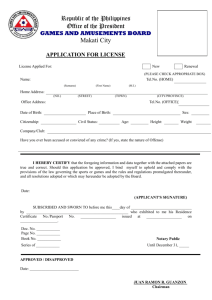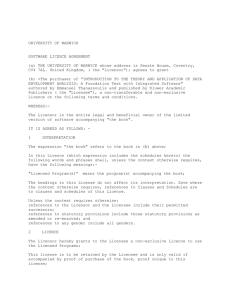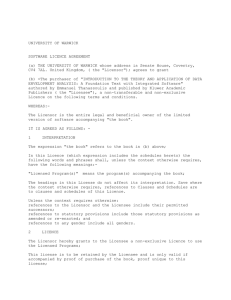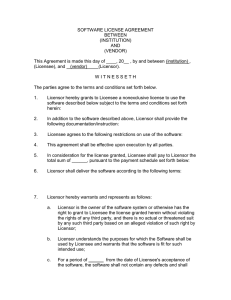Workshop on Contract Drafting and Patent Licensing
advertisement
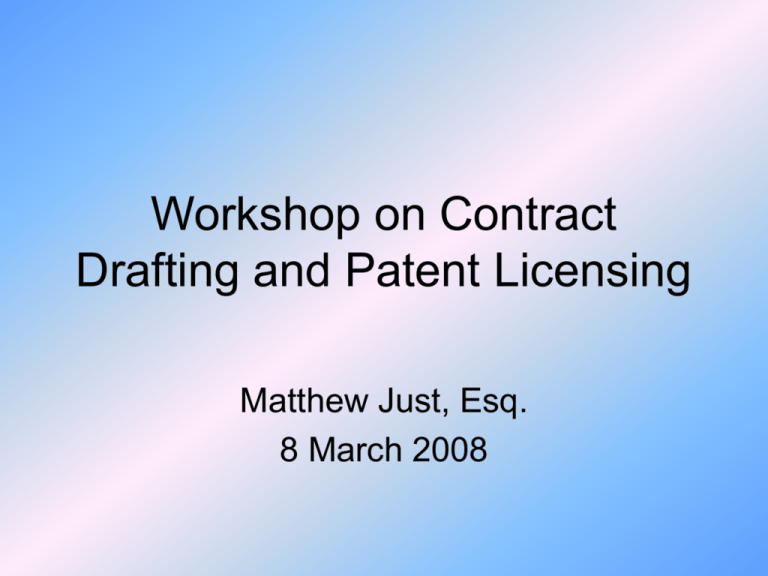
Workshop on Contract Drafting and Patent Licensing Matthew Just, Esq. 8 March 2008 Workshop Outline 1. 2. 3. 4. 5. 6. 7. 8. 9. Introduction to Drafting Contract Language Principles of Contract Interpretation Contract Drafting Basics Contract Elements in Detail Boilerplate Provisions Patent Licensing Solution to the Patent Licensing Scenario Final Thoughts 1. Introduction to Contract Drafting • What is the goal of contract drafting? • How can a contract be precise? • Who should draft the contract? 2. Contract Language What makes contract language “special”? • • • • Mixture of languages Desire to avoid ambiguity Habit Pressure to conform Examples of Unusual Language • Doublets and Triplets • Deeming • Here-, there-, and where- words • Other old-fashioned language Obligations, Authorisations and Conditions • Avoid the overuse of “shall” Use “will” to state a future fact Use “shall” to state an obligation Use “may” to state an option or a right Use “must” to state a condition precedent Special Issues for Chinese Writers • • • • • Articles (a, an, the) Tense Grammar (particularly prepositions) Punctuation (Over)Use of Chinese-English dictionaries Characteristics of Plain English 1. 2. 3. 4. 5. 6. 7. 8. Short sentences Definite, concrete, everyday language The active voice Tabular presentation of complex information Separate paragraphs and sections, with headings, for separate concepts The absence of highly legal jargon or highly technical business terminology and use of Latin or other foreign languages The absence of double or multiple negative The use of multiple columns of text if the font is small Benefits of Drafting in Plain English • • • • Increased Efficiency and Understanding Fewer Errors Positive Image for the Legal Profession Compliance with statutory Requirements • BUT: There is resistance! 3. Principles of Contract Interpretation I. The document must be read as a whole II. The Literal and Golden Rules III. Ut res magis valeat quam pereat IV. Contra Proferentem V. Noscitur a sociis Principles of Contract Interpretation VI. Ejusdem generis VII. Expressio unius est exclusio alterius VIII. Commercial (purposive) Purpose IX. UCC §3-114 on Contradictory terms. 4. Structure of a Contract • • • • • • • • • • Title Introductory paragraph Preamble / Recitals / WHEREAS Clauses Definitions Operative Clauses Representations, warranties, covenants, indemnities, guaranties, releases Events of default and remedies Boilerplate Signature Block Exhibits and Attachments Titles • All CAPITAL letters • Centered and Underlined • Use a generic term Introductory Paragraph Example: • This Agreement (hereinafter referred to as the "Agreement") is made by and between XYZ Inc. (hereinafter referred to as "Licensor"), a corporation with principal offices at 1 Main Street, Buffalo, New York, and ABC Company, a limited company with principal offices at 250 Zhong Zhen Road, Taipei, Taiwan (hereinafter referred to as "Licensee"). Preamble / Recitals • WHEREAS … Facts about: • Relationship and goals of the parties • Nature of the transaction • Other related transactional documents … The parties agree as follows: Definitions Inclusive: “Intellectual Property” means intellectual property as that term is generally used and includes all patents, copyrights, and trademarks. Exclusive: “Intellectual property” means patents, copyrights, and trademarks. Signature Block The Parties agree to the terms of this Agreement above. Licensor Licensee XYZ Inc. By: ________ Name: John Smith Title: President ABC Company A Limited Company By: __________ Name: Kevin Chang Title: Owner 5. Contract Elements in Detail • Representations and Warranties • Covenants • Conditions Precedent • Remedies • Language to soften provisions Representations and Warranties • Distinction is not normally important • They tend to be coupled: “Party represents and warrants that…” • Creates a snapshot of the facts • Important for assigning risk and due diligence • Drafted in present or past tense Covenants • Affirmative covenants • Negative (Restrictive) covenants • Financial covenants Example: “Licensee shall pay Licensor a royalty of five percent (5%) of Licensee's selling price for each Licensed Product manufactured, used, or sold by Licensee in the Territory or imported by Licensee into the Territory.” Conditions Precedent • Requirements that must be satisfied before a party has to perform or before the contract is enforceable • Simultaneous Closing vs. Delayed Closing Remedy Provisions • Triggering Event Remedy Four types – Termination – Acceleration – Indemnification – Liquidated Damages Remedy: Termination “In the event Operator defaults in the performance of any covenant or agreement made hereunder, as to payments of amounts due hereunder or otherwise, and such defaults are not remedied to the Supplier’s satisfaction within ten (10) days after notice of such defaults, the Supplier may thereupon terminate this agreement and all rights hereunder of the Operator but such termination shall not affect the obligations of the Operator to take action or abstain from taking action after termination hereof, in accordance with this agreement.” Remedy: Acceleration “Whenever, within the sole judgment of Seller, the credit standing of Buyer shall become impaired, Seller shall have the right to demand that the remaining portion of the contract be fully performed within ten (10) days.” Remedy: Indemnification • Breaching party indemnifies (pays back) innocent party for all costs, damages and losses suffered as a result of the breach • Could be limited by baskets or caps. Remedy: Liquidated Damages • Specific payment upon occurrence of certain event. Could be unenforceable (a penalty): • Is the actual damage from breach difficult to calculate? • Was a good faith effort made to estimate the damage? Softening Remedies • Materiality “[Breach]…in any material respect.” • Grace (cure) Periods Softening Contract Provisions Stronger Good Faith Reasonable Efforts Diligent Efforts Best Efforts 6. Boilerplate Provisions What does “boilerplate” mean? • Miscellaneous • Pre-litigation planning • NOT unimportant! Arbitration • Why go to arbitration? Example Clause: “Any controversy or claim arising out of or relating to this Agreement, or its breach, is to be settled by arbitration administered by [organization] in accordance with its [subject matter] Rules.” • Arbitration or Mediation? Choice of Law • ALWAYS include this provision • Which law should you choose? Example: “This Agreement and the rights and obligations of the parties hereunder shall be governed by, and construed and interpreted in accordance with, the laws of the State of New York, without regard to its choice of laws principles.” Consent to Jurisdiction • Choice of forum provision Example: “Each party shall submit to any court of competent jurisdiction for purposes of the enforcement of any award, order or judgment. Any award, order or judgment pursuant to arbitration is final and may be entered and enforced in any court of competent jurisdiction.” Waiver to Trial by Jury • Why waive the right to a jury? Clause must be: • Binding on both parties • Conspicuous – bold or CAPS Counterparts • Contract may be executed separately by parties • Common for international agreements Headings • What is the proper function of headings? Example: “The descriptive headings of the Articles, Sections and subsections of this Agreement are for convenience only, do not constitute a part of this Agreement, and do not affect this Agreement’s construction or interpretation.” Severability • Remove (sever) void provision and interpret the remainder • Remainder must still represent the bargain Integration • The contract is the whole agreement • No other oral or written promises • Invokes the Parol Evidence Rule Waivers • No Oral Waivers • Effect of failure or delay to enforce rights • Written waivers are limited to one occasion Amendments • In Writing • Signed • Identify the original agreement Example: “The parties may amend this Agreement only by a written agreement, signed by the parties, that identifies itself as an amendment to this Agreement.” Assignment and Delegation • Assignment of rights or delegation of duties to a third party • Only with prior written consent from other party • Issue of control – important to know who you are dealing with Costs and Expenses • Parties cover their own expenses unless otherwise stated. • Minor, but it avoids arguments Further Assurances • Attempts to deal with unforeseen circumstances Example: “The parties agree to do such further acts and things and to execute and deliver such additional agreements and instruments as may be reasonably necessary to give effect to the purposes of this Agreement and the parties’ agreements hereunder.” 7. Patent Licensing • What is a license? • Types of Licenses – Exclusive License – Non-Exclusive License – Paid-Up License – Running Royalty License – Cross License Structure of a License Agreement • • • • • • • • • • Title Introductory Paragraph Preamble / Recitals Definitions Grant Royalties Representations and Warranties Term and Termination Boilerplate provisions Signature Block Definitions • Licensed Patents • Licensed Products • Territory Patent Marking • Why is marking important? • Licensor may ask to inspect Licensee’s products Patent Enforcement • Who should sue infringers? • Do we always want to sue infringers? • How should the court award (compensation) be distributed? Representations and Warranties • What should the Licensor promise? – That the patent is valid? – That the Licensor can grant a license? – That there are no rights of third parties? • What should the Licensee promise? – Paying Royalties? – Best efforts in selling product? Improvements • Licensor’s Improvement – Can the Licensee use it? – Additional Fee? • Licensee’s Improvement – Can Licensor use it? If so, to what extent? – If patentable, who gets the new patent? Indemnification • Licensor may want to be indemnified against tort actions in relation to use of the final product • Licensee indemnification depends of bargaining power Royalty Rate • Agreed on in negotiations and put into contract • If disputed, Georgia-Pacific 15 factors may be relevant 8. Solution to the Patent License Scenario • • • • • Exclusive or non-exclusive? Paid-up or Running Royalty? Territory? Improvements? What if a dispute arises? 9. Final Thoughts: Precedents • Where can we find precedents? • Use multiple, relevant precedents • Get first and final drafts • Think before copying 9. Final Thoughts on Contract Drafting
